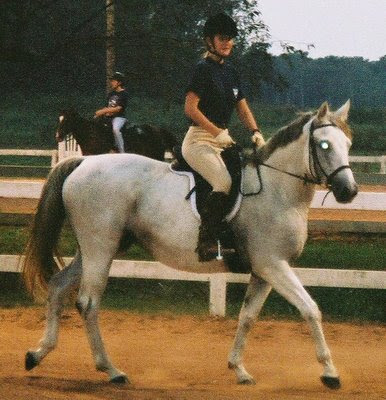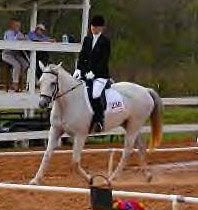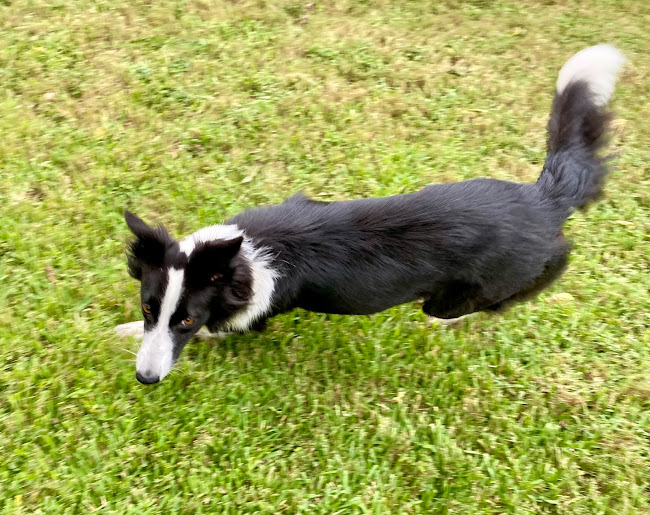Wednesday, March 25, 2009
Self Carriage
The second level horse must have self carriage in order to progress. In working toward self carriage in our lesson today, Karen had me raise Delphi's neck with the reins, thereby unlocking the gullet. Once the gullet is open and soft, give a series of unilateral half halts, then immediately completely giving the rein. The key is in the give; when the horse is softly on the bit the rider must allow the horse to carry itself by not hanging on the rein nor allowing the horse to hang on the rein, rather continuing to raise the horse's neck and applying the unilateral half halts, then again giving the rein to allow self carriage.
Saturday, March 21, 2009
Uphill Canter
In our quest for improved canter departs, Delphi and I worked almost exclusively on canter in our lesson today. The transitions are becoming more obedient; we're still working to improve relaxation during and after the up trans to canter. An exercise Karen gave us: keep the jaw (and thereby the poll) supple by flexions left and flexions right, and keep the neck up where the horse can comfortably take the upward trans and keep its hindquarters jumping under its body by activating the hindquarters. Do this by half halting up: at this stage I keep my elbows pressing down and into my sides while actually raising my hands up. Yes, there should be a straight from your hand to the bit, but when the horse is correctly lifting its entire forehand (not the neck only) and lowering its haunch in the "jump" into canter, there will be a direct line from hand to bit even when it feels like (to me at this point) my hands are way up high. As always, after the half halt (however strong!) allow the horse to find self carriage by softening-- completely softening the rein then repeat, repeat, repeat the process of half halting up, engaging the hindquarters to jump under the horse, then giving to allow self carriage. We were able to get some counter canter shallow loops and counter canter three loop serpentines (we rode six in a row by going the arena twice in each canter lead!). A very satisfactory lesson for both Delphi and me.
Wednesday, March 18, 2009
United States Dressage Federation

Tuesday March 17 I get an email from the USDF with my member number and congratulations for my lifetime membership status. What the? Immediate call to Chris at work to ask if there's anything he wants to tell me? At first he played coy but then admitted he intercepted my renewal in the mail and decided I should join lifetime so I don't have to worry about it each year. So now I'm a lifetime participating member of the USDF. Thank you Chris!
Delphi is also lifetime registered with USDF.
Wednesday, March 4, 2009
Changes of Bend
Riding changes of bend, such as when making serpentines, have proven challenging. To improve our changes of bend, Karen gave us an exercise of a four loop serpentine of ten meter turns, from quarterline to quarterline. We started in trot on our sticky side, the right rein. Much before crossing the centerline, begin stepping your weight into the new direction of bend (the left stirrup in this example), half halting then leg yielding away from the new inside (left) leg, and only then changing the bend. For Delphi the half halt is important and should be very firm, almost a full halt, so that she stays obedient. You're riding the horse's body and being aware of how it's carrying itself rather than fidgeting with the neck and reins in a false attempt to change the bend in the neck only. Before you again cross the next centerline, begin "jumping" down on the new inside (right) leg (which correctly places the weight aid for the new bend), half halt and leg yield away from the new inside (right) leg, then change the bend. This keeps the horse supple, forward, and changes the bend through the body rather than attempting to change it through the neck only.
We also worked on moving the haunches in, then bringing the horse's haunches out again to align the haunches with the shoulders, while in walk or trot along the rail. The key is keeping the neck relatively straight; there is a slight bend to the outside when initially moving the haunches in, but when returning the haunches out to match the shoulders, the neck should really stay straight rather than over bending to the inside.
And of course, no lesson is complete without the ol' canter transitions. We worked on walk to canter today; both directions were very obedient on Delphi's part, which is good. However we're still working on roundness through the transition, and becoming more uphill once in canter. It's definitely a work in progress.
We also worked on moving the haunches in, then bringing the horse's haunches out again to align the haunches with the shoulders, while in walk or trot along the rail. The key is keeping the neck relatively straight; there is a slight bend to the outside when initially moving the haunches in, but when returning the haunches out to match the shoulders, the neck should really stay straight rather than over bending to the inside.
And of course, no lesson is complete without the ol' canter transitions. We worked on walk to canter today; both directions were very obedient on Delphi's part, which is good. However we're still working on roundness through the transition, and becoming more uphill once in canter. It's definitely a work in progress.
Monday, March 2, 2009
Then and Now, a story in photos
2005


2006
 2007
2007

2008
 2009
2009
The present. I'm walking again. "Normalcy" resumes. Delphi is being schooled second level regularly by Karen Brown, I take a weekly lesson and ride Delphi most days, and shows and clinics play a major role in our training regime:


 God is good, and I'm thankful.
God is good, and I'm thankful.
The day Delphi was delivered, just after hurricane Rita (our very first ride, and I was thrilled):

Delphi's training level debut (she took Reserve High Point of the entire show):

2006
Delphi continues her show career:
 2007
2007
2008
The dark days. Both photos were taken on the same day, while I lay in the hospital.
Delphi, looking neglected, before Karen rescued her:
Delphi, looking neglected, before Karen rescued her:
 2009
2009The present. I'm walking again. "Normalcy" resumes. Delphi is being schooled second level regularly by Karen Brown, I take a weekly lesson and ride Delphi most days, and shows and clinics play a major role in our training regime:


 God is good, and I'm thankful.
God is good, and I'm thankful.Then and Now. A before and after shot of Delphinia as an untried filly, and today as a mare in full bloom:
Subscribe to:
Posts (Atom)





